Sue Burke's Blog, page 11
November 6, 2023
My story in ‘The Cosmic Muse’ anthology, and other news
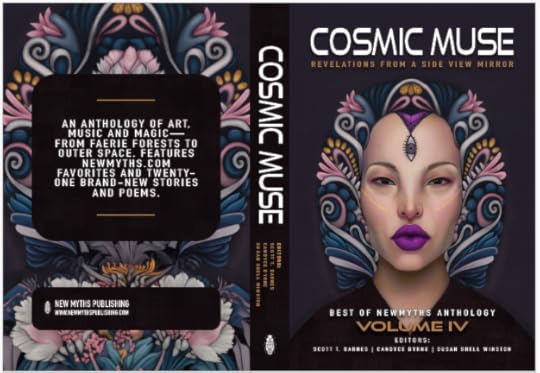
What if you could adopt rescue dragons the way you can adopt rescue dogs? Who would do the adopting? How? Where?
These questions led to my story “The Virgin Who Rescues Dragons” in NewMyths Anthologies Volume 4: The Cosmic Muse. It just came out, and you can buy it through this link:
https://books2read.com/b/br6Z67
I drew inspiration for my story from The Tough Guide to Fantasyland by Diana Wynne Jones. That book is a parody of tourist guidebooks, and it lists the common tropes of fantasy fiction. I studied up on Dragons, Virgins, Evil Mages, Boy Kings, Dark Lords, and Foreboding Castles, then added a few Compelling Motivations, Backstories, and Inner Conflicts — and soon, I had a fun tale to tell.
The Cosmic Muse will give you 40 stories and poems involving magic or expressing awe at the universe, with cover art by Fiona Meng, its third eye promising insight and inspiration. I’m excited to be included among so many impressive authors.
***
OTHER NEWS:
André Santana has been nominated for Best Science Fiction Audiobook Narration for Dual Memory by SOVAS, the Society of Voice Arts and Sciences. Congratulations André! The winner will be announced December 10.
Alex Kingsley has reviewed Dual Memory for Ancillary Review of Books, and I think they explain wonderfully the role of art and artists for both humans and AIs in the novel. Beautiful Things We Weren’t Supposed to Make: Review of Dual Memory by Sue Burke
November 3, 2023
Merriam-Webster adds nyctinasty

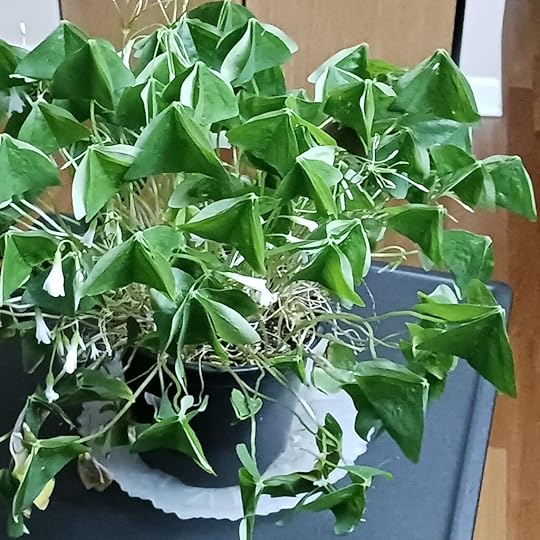
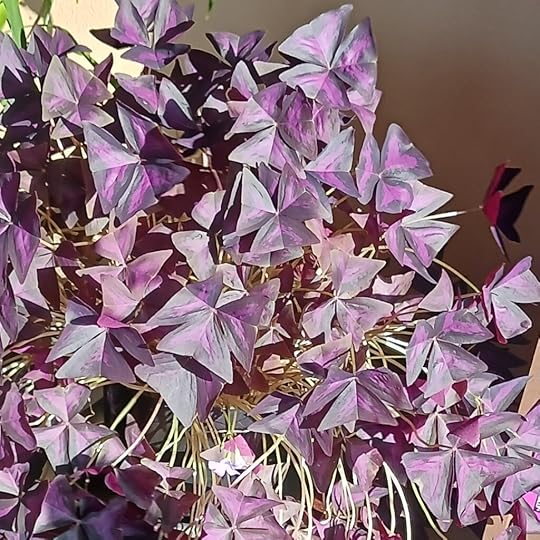
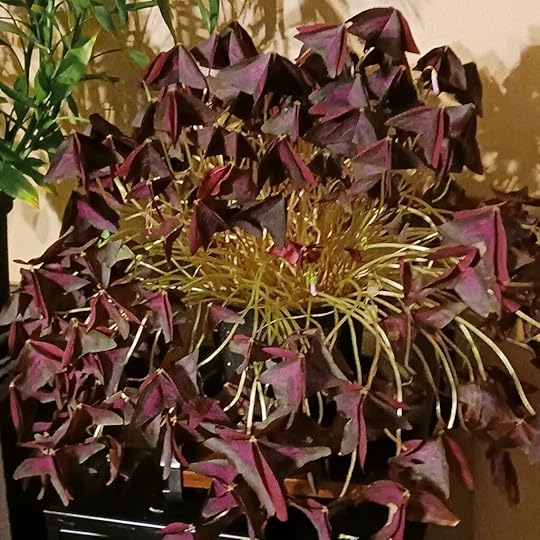
This fall, Merriam-Webster.com updated its dictionary with 690 new words. One of those words is nyctinasty, a noun meaning “plant movement (such as the closing of a flower’s petals or the reorientation of a leaf’s position) that occurs in response to changes in light intensity (such as the onset of darkness) and that typically involves changes in cellular turgor: the nastic movement of the parts of some plants that occurs in the absence of a directional stimulus and that is associated with the plant’s circadian cycle.”
Basically, it means that the plant folds up parts, like leaves and flowers, at night. The plant snuggles up and goes to sleep. The prayer plant (Maranta leuconura) is one example. Other common nyctitropic plants are some species of Oxalis, also known as wood sorrel or false shamrocks. They’re often sold around St. Patrick’s Day in the United States.
St. Patrick’s Day sales are how I got the two plants shown in the pictures, Oxalis triangularis (the purple one), and Oxalis regnellii, also called Oxalis triangularis ssp. papilionacea (the green one). The difference is day and night: plants on the move.
The word has been around in botanical circles for a long time. Merriam-Webster decided that nyctinasty isn’t a niche word anymore. It’s now safe for non-scientists to use, so use it wisely and often.
November 1, 2023
‘Alphaland and Other Tales’ by Cristina Jurado
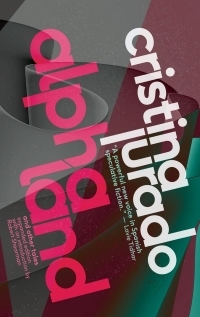
My good friend, Cristina Jurado, has a new collection of short stories available, Alphaland and Other Tales. It includes a story I translated from Spanish into English, “Embracing the Movement.”
I met Cristina when I was living in Spain, and I’ve collaborated with her on a number of projects. She’s an award-winning author, enthusiastic editor, and cheerful promoter of speculative fiction. You can recognize her from across a room by her wide, warm smile.
This collection includes nine short stories, and the back cover describes them this way: “Otherness is the idea that permeates all these speculative stories, full of characters troubled by the misconstruction of their identities, and in permanent search for answers in the margins of reality.”
I translated “Abrazar el movimiento” (Embracing the Movement), an intense first-contact story whose beautiful images hide horror.
Every translation has delightful problems. Many words never have exact equivalents. In this case, the challenge started with the first sentence: No somos tan diferentes, forestera. “We are not so different…” and then there’s that word: forestera. It is used repeatedly throughout the story, and I had to get it right.
The Real Diccionario Española defines forastero/a as someone or something que es o viene de fuera del lugar: “that is or comes from another place,” a stranger, an outsider. But there’s more: forastero is male, forastera is female. In the context of the story, it matters that the person being addressed is identified as female. I needed to find a way to preserve that sense.
Thesauruses listed close-but-not-quite words like foreigner, nonnative, outlander, alien, nonresident, drifter, transient, wanderer … which led to nomad, rambler, roamer, rover, stroller, vagabond, wanderer, wayfarer … Wait. The word rover suggested something … the Mars rovers, Perseverance, Curiosity, Spirit, Opportunity, and Sojourner. The Sojourner was named after Sojourner Truth. In 1797, she was born into slavery as Isabella Bomfree in New York State, and after she became free, she chose a new name because she felt called to travel and testify for the abolition of slavery and for the improvement of women’s rights.
“Sojourner” means someone who stays as a temporary resident, who comes from another place. The word in English has associations with space exploration, and it’s a name still being .
I decided I’d found the word for forastera, although I needed to reinforce the female meaning in the first reference, and I realized that I could do so by introducing an important element from further within the story. Finally, I had the opening line in English:
“We are not so different, sister sojourner.”
October 25, 2023
“Perhaps you wrote this story, and then I happened”
This is weird and wonderful:

The very first short story I sold, back in 1995, “Poet for Hire,” involved a young woman with curly brown hair who starts a freelance poetry business in Milwaukee. She works out of a storefront in the 2200 block of Kinnickinnic Avenue, down the street from where I used to live, and she gets vital inspiration from the plants in the Arid Dome of Milwaukee’s Mitchell Park Horticultural Conservatory.
Last month I was contacted by Anja Notanja Sieger. Someone found the story and sent it to her — because she’s Milwaukee’s first poet for hire, she has written poems in the Arid Dome, her husband owns a used bookstore in the exact same storefront in the story, and she has curly brown hair.
Anja invited me to her podcast, The Subtle Forces. I read the story out loud, and we chatted about its coincidences. “Perhaps you wrote this story,” she said, “and then I happened.”
You can listen to the podcast here:
https://subtleforces.podbean.com/e/episode-37-poet-for-hire/
October 23, 2023
I’ve finished the final book in the Semiosis trilogy
I’ve turned in the manuscript for Usurpation, the third book in the Semiosis trilogy. At the end of the second book, Interference, rainbow bamboo has been taken to Earth and is flourishing, and Stevland tells them to protect and dominate the humans. But how? The third book tells that story.
Usurpation should appear in bookstores in October 2024.
A whole year from now! Yes, it seems like a long time, but a lot still needs to be done. My editor at Tor might suggest a few more changes, such as adding a scene that could strengthen the story. Then the manuscript will be sent to a copyeditor.
Good copyeditors are far, far more than proofreaders. As they go over the manuscript, they will make a glossary or stylesheet of names of characters, places and other terms, and they’ll check to see that they are used consistently. They’ll note distinctive formatting or punctuation, and make sure the text conforms overall to the Chicago Manual of Style and a standard reference dictionary. They might need to check facts, such as dates of actual historic events. They also look for inconsistencies in the story: Becky might have blue eyes in Chapter 2 but brown eyes in Chapter 3. They’ll go line by line and make sure every sentence makes sense. Copyeditors have saved me from many howling mistakes, and they have my affection and respect. I don’t want them to rush.
After I review and approve the copyeditor’s changes and suggestions, the manuscript will be typeset, which is an art in itself. Then it will be proofread — twice. The proofreaders might have additional questions for me.
Meanwhile, an artist will design the cover. Finally, the package will be sent to a printer, and the printed books will be sent to a distributor.
If there’s an audiobook, and I’m sure there will be, the audiobook publisher will select the narrator, who will begin the work of reading the novel aloud creatively.
The final steps are marketing, sales, and publicity, and I may have a lot to do to promote Usurpation before and after the publication date.
Still, for me, the hard part is done, and right now, I’m thinking about my next novel. It won’t be about talking trees … but what? It’s a nice problem to have to solve. Any suggestions?
October 18, 2023
My votes for the 2023 Hugo Best Novella
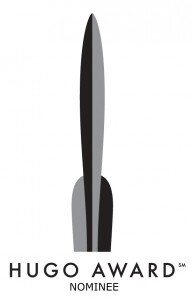
This year the Worldcon will be held in Chengdu, China, and the 2023 Hugo Awards, the Lodestar Award, and the Astounding Award will be presented on Saturday evening, October 21, at a formal ceremony at the Chengdu Worldcon.
Although I won’t be attending in person, I’m a Worldcon member and get to vote for the awards. Members also make the nominations, and the works or individuals with the most nominations become the finalists.
While all these works are solid and any one of them deserves to win, I was disappointed that no Chinese novellas were finalists.
The voting is by ranked choice, and here’s my ranking:
6. Where the Drowned Girls Go, by Seanan McGuire (Tordotcom) – Cora, a girl who has gone through a portal, faces bullying and institutional abuse as she tries to adjust to our world. This is part of the Wayward Children series. It’s a heart-wrenching story, but not quite a stand-alone.
5. Into the Riverlands by Nghi Vo (Tordotcom) – This story is part of the Singing Hills Cycle. A wandering cleric joins a group of travelers, and they share stories between episodes of epic martial arts in which they battle notorious bandits. Clever and consistently interesting.
4. A Mirror Mended by Alix E. Harrow (Tordotcom) – Fairy tales are filled with problematical characters and situations, and they get their comeuppance. The various versions of Snow White all lead to trouble, told by a witty but anguished would-be rescuer. A fun examination of metastory.
3. What Moves the Dead by T. Kingfisher (Tor Nightfire) – A very creepy retelling of “The Fall of the House of Usher” by Edgar Allan Poe, with an engaging voice and outstanding characters. Simply well done.
2. Ogres by Adrian Tchaikovsky (Solaris) – What seems like a fantasy story at first turns into a dystopia. Nothing more can be said without spoilers. The choice of second-person narration turns out to be important.
1. Even Though I Knew the End by C.L. Polk (Tordotcom) – In Chicago in the 1930s, the “White City Vampire” seems to be an ordinary serial killer, but a private detective knows that a lot more is at stake — more than she thinks, in fact. Can she protect her beloved? Demons, warlocks, and angels keep the plot twisting and turning. This novella won the Nebula Award.
October 16, 2023
Audubon Talk Nov. 9 on “The Costs of Plant Blindness”
I’ll be giving a Zoom talk on Thursday, November 9, from 6 to 7 p.m. CST for the Audubon Society of Northern Virginia about plant blindness, the inability to see or notice plants in everyday life. It also refers to failing to recognize the role of plants on Earth and believing that plants are somehow inferior to animals.
When I wrote Semiosis, one of my secret goals was to make my readers afraid of their gardens and afraid for plants in general. I’ll speak on how plant blindness affects our environment and what can be done to be more aware of the foundation of our ecosystems. Plants, like birds, connect us to the Earth.
You can join us. Sign up here.
October 11, 2023
My votes for the 2023 Hugo Best Novelette

This year the Worldcon will be held in Chengdu, China, and the 2023 Hugo Awards, the Lodestar Award, and the Astounding Award will be presented on Saturday evening, October 21, at a formal ceremony at the Chengdu Worldcon.
Although I won’t be attending in person, I’m a Worldcon member and get to vote for the awards. Members also make the nominations, and the works or individuals with the most nominations become the finalists.
The voting is by ranked choice, and here’s my ranking — of course, your opinion may differ:
6. “The Space-Time Painter” by Hai Ya (Galaxy’s Edge, April 2022) – Alas, no translation from Chinese is available. Given the quality of the Chinese works in the short story category, I was looking forward to reading this.
5. “We Built This City” by Marie Vibbert (Clarkesworld, June 2022) – Workers maintaining the dome over a city on Venus fight for their right to do their job in reasonable working conditions. Science fiction is always about the present.
4. “The Difference Between Love and Time” by Catherynne M. Valente (Someone in Time: Tales of Time-Crossed Romance, Solaris) – An extended metaphor eventually leads to an understanding of the difference between love and time, stylishly told with an uplifting ending.
3. “A Dream of Electric Mothers”, by Wole Talabi (Africa Risen: A New Era of Speculative Fiction, Tordotcom) – Technology manages to make tradition come true: ancestors can be consulted. But should their messages be trusted? Time and place, character and theme mesh to bring the answer.
2. “If You Find Yourself Speaking to God, Address God with the Informal You” by John Chu (Uncanny Magazine, July-August 2022) – Can you be friends with a superhero? Can a superhero solve one of today’s ugliest problems? John Chu explores these questions with a tender, breakable heart, and emotional honesty suffuses every sentence.
1. “Murder By Pixel: Crime and Responsibility in the Digital Darkness” by S.L. Huang (Clarkesworld, December 2022) – Can an AI unintentionally become a killer? Using the format of a magazine article, this story has the creepy feel of our present-day reality rather than science fiction. It even has footnotes.
October 10, 2023
The Science in Fiction podcast: Sue Burke on Intelligent Plants

Marty Kurylowicz and Holly Carson invited me to join them on their podcast, The Science in Fiction — and it’s now available for your listening pleasure.
We talked about the science of botany in my science fiction novel Semiosis and its sequel Interference. Plants have a lot of surprising behaviors, and the hosts learned things they didn’t know about tulips, apples, osage oranges, and giant ground sloths.
We also discussed my novels Immunity Index about a coronavirus pandemic — which I wrote before the covid-19 pandemic — and Dual Memory, which has recently arrived on bookstore shelves. I’ve just turned in the manuscript for the third installation of the Semiosis trilogy, Usurpation, due to be published in October 2024.
The Science in Fiction podcast will follow up this episode with an interview next week with Paco Calvo, professor of the philosophy of science and principal investigator at the University of Murcia’s Minimal Intelligence Lab in Spain, and author of Planta Sapiens.
Here are all the places you can listen to Ep 12: Sue Burke on Intelligent Plants in Semiosis.
October 6, 2023
Video from the Deep Dish reading
As you may recall, back on September 14 I read a short story called “The Virgin Who Rescues Dragons” at an event here in Chicago, the Deep Dish reading series, organized by the Speculative Literature Foundation. I was one of eight readers that evening.
If you couldn’t attend, you can watch videos of us. Here’s the link to the YouTube playlist.
The piece I read will be published this fall inThe Best of NewMyths Anthology Volume 4: The Cosmic Muse. Due to time constraints, the version I performed of “The Virgin Who Rescues Dragons” is abridged. The full version has a lot more jokes, so buy the book!
Watch my video here.



